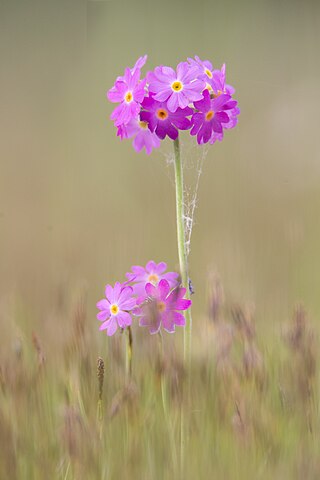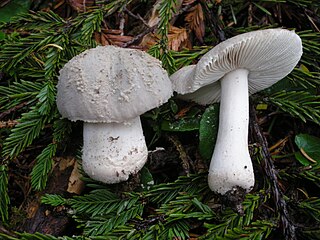
Nartheciaceae is a family of flowering plants. The APG III system places it in the order Dioscoreales, in the clade monocots. As circumscribed by APG IV (2016) it includes 35 species of herbaceous plants in the following five genera:

Primula farinosa, the bird's-eye primrose, is a small perennial plant in the family Primulaceae, native to Northern Europe and northern Asia, and (rarely) farther south at high altitudes in the mountains of southern Europe. This primrose thrives on grazed meadows rich in lime and moisture.

Encelia is a genus of the plant family Asteraceae. It consists of shrubs of arid environments in southwestern North America and western South America.

Encelia farinosa, is a common desert shrub of the southwestern United States and northern Mexico. It has a variety of historical uses.

The southern mealy amazon or southern mealy parrot is among the largest parrots in the genus Amazona, the amazon parrots. It is a mainly green parrot with a total length of 38–41 cm (15–16 in). It is native to tropical Central and South America. This parrot and the northern mealy amazon are considered conspecific.

Campanula glomerata, known by the common names clustered bellflower or Dane's blood, is a species of flowering plant in the genus Campanula, belonging to the family Campanulaceae. It is the county flower of Rutland, England.

Amanita farinosa, commonly known as the eastern American floury amanita or the American floury amanita, is a North American poisonous mushroom of the genus Amanita, a genus of fungi including some of the most deadly mushrooms.

Peronospora farinosa is a species name that has been widely applied to downy mildew on leaves of wild and cultivated Amaranthaceae: Amaranthus, Atriplex, Bassia, Beta, Chenopodium, Halimione, Salsola, Spinacia, etc. However, the species name has been taxonomically rejected as the original description contained reference to multiple species and could not unequivocally be attributed to a species of Peronospora. In the past, some of the species on important crop plants have been given names as formae speciales, notably f.sp. betae on sugar beet and f.sp. spinaciae on spinach. However, phylogentic reconstructions have revealed that these "forms" of Peronospora on different genera and their subdivisions, are distinct species, most of which already have previously published scientific names. Such host specialization possibly also exists with respect to the various wild amaranthaceous species given as hosts of P. farinosa.

Peronospora farinosa f.sp. betae is a forma specialis of Peronospora farinosa, attacking sugar beet.

Dudleya farinosa is a species of succulent plant in the family Crassulaceae known by several common names, including bluff lettuce, powdery liveforever, and powdery dudleya. A coastal plant of northern California and southern Oregon, it is typically found on oceanic bluffs just directly above the reach of the waves. Its appearance is characterized by lotus-like rosettes of beveled leaves, and in summer the plant erects a tall pink to red stem densely covered in foliage, topped with branches adorned with pale yellow flowers. The green or white rosettes of this plant can be seen covering stretches of rocky coast and nearby islets.

Acacia farinosa, commonly known as mealy wattle, is a shrub that is endemic to Australia. It grows to between 1 and 2 metres high and has ascending phyllodes. The yellow globular flower heads generally appear between August and October in its native range. These are followed by curled and twisted pods which are up to 6 cm long and 2–3 mm wide.

3-Acetyl-6-methoxybenzaldehyde is a chemical compound found in the leaves of Encelia farinosa.

Monochroa servella is a moth of the family Gelechiidae. It is found from Fennoscandia to Italy and from Portugal to Bulgaria and Russia.

Aletris farinosa, called the unicorn root, true unicorn, crow-corn, white colic-root or white stargrass, is a plant species found across much of the eastern United States. It has also been reported from the southern part of Ontario, Canada. It is known from every state east of the Mississippi River except Vermont, as well as Texas, Oklahoma, Arkansas and Louisiana. Its native habitats include moist peaty, sandy or gravelly areas.
Nigrolamia borussa is a species of beetle in the family Cerambycidae. It was described by Karl Jordan in 1903.
Nigrolamia ogowensis is a species of beetle in the family Cerambycidae. It was described by Dillon and Dillon in 1959.

The mealy amazon or mealy parrot is among the largest parrots in the genus Amazona, the amazon parrots. It is a mainly green parrot with a total length of 38–41 cm (15–16 in). It is native to tropical Central and South America. This species, the southern mealy amazon, the northern mealy amazon are considered conspecific.

Cadaba farinosa is a 2–8 m (6.6–26.2 ft) high evergreen shrub or small tree that belongs to the caper family. It has simple ovate leaves with entire margins, zygomorphic, spidery, greenish, yellowish, whitish or pinkish flowers, and is covered in powdery hairs or scales, particularly the younger parts. It can be found in a zone from Senegal to India between the desert and the savanna.

Gonepteryx farinosa , the Powdered Brimstone, is a butterfly found in the Palearctic that belongs to the whites family.

Ritsa Strict Nature Reserve is a protected area in the Gudauta District of Abkhazia, in the country of Georgia. The reserve's main goal is to protect Lake Ritsa and conserve the ecosystems and species located in the surrounding mountain regions.














